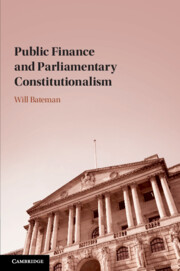Book contents
- Public Finance and Parliamentary Constitutionalism
- Public Finance and Parliamentary Constitutionalism
- Copyright page
- Dedication
- Contents
- Figures
- Preface
- Acknowledgements
- Notes on the Text
- Abbreviations
- 1 Finance and Constitutionalism
- Part I Historical Development of Parliamentary Public Finance
- Part II Parliamentary Public Finance in Operation
- Part III Evaluating Parliamentary Public Finance
- Bibliography
- Index
1 - Finance and Constitutionalism
Published online by Cambridge University Press: 16 September 2020
- Public Finance and Parliamentary Constitutionalism
- Public Finance and Parliamentary Constitutionalism
- Copyright page
- Dedication
- Contents
- Figures
- Preface
- Acknowledgements
- Notes on the Text
- Abbreviations
- 1 Finance and Constitutionalism
- Part I Historical Development of Parliamentary Public Finance
- Part II Parliamentary Public Finance in Operation
- Part III Evaluating Parliamentary Public Finance
- Bibliography
- Index
Summary
This chapter introduces the central questions broached in the book. How does law distribute authority over public finance between constitutional institutions? How did that law develop? What role do economic, financial and administrative conditions have on the distribution of financial authority between parliaments and executive governments? Do judiciaries play a meaningful role in supervising public finance? Does it make sense to understand parliaments to 'control' public finance in the parliamentary tradition of government? The chapter opens by explaining AV Dicey's understanding of parliamentary control of public finance and his influence on later academic and practical engagements with the financial aspect of constitutionalism. Critical financial concepts are then explained, particularly the different functions performed by fiscal activities (taxing and spending), debt finance and monetary finance. The dominant position of 'central' government finance to the modern constitutional state is introduced and the distinction between 'parliamentary' and 'congressional' constitutional systems is clarified. The chapter closes by summarising the book's major claims.
Keywords
- Type
- Chapter
- Information
- Public Finance and Parliamentary Constitutionalism , pp. 1 - 20Publisher: Cambridge University PressPrint publication year: 2020

